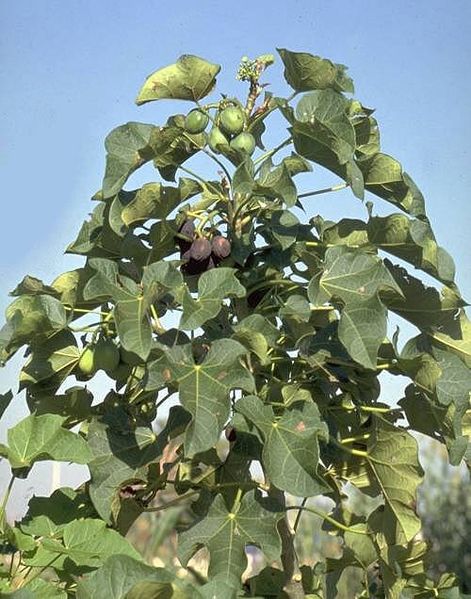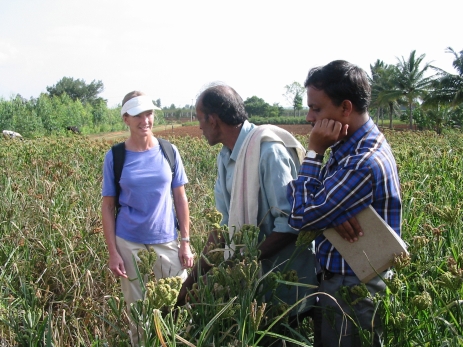I admit I haven’t been paying the most attention to the topic of biofuels the past few years, after studies made fairly clear that the social, energy, and environmental benefits of the predominant player, corn ethanol, were generally overhyped when factors like oily fertilizers and the wisdom of converting more land to corn came into play.
 Would Roz by any other name find biofuels as sweet?Photo: Roz NaylorAs it turns out, this not-uncommon assumption, that the biofuel bubble has burst, is an a-maize-ing farce, pointed out Rosamond (Roz) Naylor, professor of environmental earth systems and economics at Stanford, in the second “Eating Your Environment” lecture I attended at the University of Washington last week.
Would Roz by any other name find biofuels as sweet?Photo: Roz NaylorAs it turns out, this not-uncommon assumption, that the biofuel bubble has burst, is an a-maize-ing farce, pointed out Rosamond (Roz) Naylor, professor of environmental earth systems and economics at Stanford, in the second “Eating Your Environment” lecture I attended at the University of Washington last week.
Biofuel producers continue gushing out more and more biodiesel and ethanol each year: According to Naylor, the industry is expected to reach 24 billion gallons in 2010. Biofuels now make up 2 percent of total transportation fuel around the world, somewhat diluting the amount of petroleum we’re pumping into our engines, at least directly. That may not seem like much compared to the 1.3 trillion gallons of gasoline consumed last year, but Asia’s rapidly growing appetite for transportation fuels raises the question of whether the world can support such a massive transition from bicycle power to crude oil and ethanol. Unlike actual hunger, appetites for transportation fuels seem to be insatiable while the geological and biological systems producing these fuels have very real limits.
As a result, energy and agriculture are intertwined as they have never been before. You can see this connection in the way the prices of crude oil and corn move together in the newest dance on the financial floor. Until 2005, the price of corn was independent, while the price of gasoline has consistently mirrored that of crude; after 2005, corn and crude have had a very strong positive correlation. When the price of crude goes up, corn is sure to follow.
What does all of this talk about commodity corn prices have to do with food? Many believe biofuels are responsible for a 25 to 35 percent increase in food prices (as cited in this 2010 World Bank report [PDF]), and as Naylor put it, “Food prices make a difference, particularly for poor peoples.”
Consider that one SUV tank’s worth of corn ethanol can provide enough food to sustain a person living in a developing country for a year. That bit earned Naylor a collective, horrified gasp from the audience. (Asked later for the source, she and a colleague provided this 2008 World Development Report from the World Bank [PDF] which makes this claim, spelling out that 529 pounds of maize would fill a 26.4 gallon tank, but which also lacked a source for the numbers. So take it with a grain of salt — and a grain of corn.)
Weigh that SUV tank of corn against the projection that the world will need to crank out 70 percent more food to satisfy the population of 2050. Where will that food come from? One answer reveals another emerging dance partner for agriculture — the global financial sector (who’s ready to hedge some funds?).
Some people seem to think, Naylor recounted, this extra food will come from places like Cambodia, Ethiopia, Liberia, and Mozambique, where international financial investors are gobbling up land, in the name of agricultural development. Not coincidentally, most of the sales occur in countries with poor land governance, where it is not clear who owns the land. There’s a glaring, but not entirely unexpected, lack of accountability as firms buy and sell this land (again, supposedly for farming): 75 percent of these transactions are in Sub-Saharan Africa and only 20 percent have actually been converted to agriculture. A boom in biofuels makes these sort of foreign land grabs look like attractive and popular investments, but with troubling potential consequences for the land and the people actually on it. (Images of pre-housing bust sprawl are dancing through my head.)
As Purdue University professor Gebisa Ejeta made clear in the previous lecture I covered, the world’s hungry can’t afford the luxury of possible, eventual agricultural development in areas such as Sub-Saharan Africa, especially when such food-growing is divorced from the resources and needs of the local communities — and destined for export. However, Ejeta seemed to see these foreign land investments less as something to fear and more — if done right — as an “opportunity to receive investment in local African people.”
 Jatropha: Miracle oil or snake oil?Photo: R.K. Henning, Jatropha.orgJatropha is one biodiesel source many enthusiasts hope could serve as one such “pathway out of poverty” for Africa, as Naylor put it. A supposed wunder-shrub that may thrive on marginal and arid lands, jatropha’s oily seeds could be an economic and energy solution in some instances. However, the science of scaling up production isn’t yet there and neither is the widespread policy to support it, according to Naylor. Small farmers in Mozambique, for example, haven’t seen the expected boost in income from welcoming jatropha [PDF], and in some cases, farmers may have stopped growing food crops as a result. Second-generation biofuels are supposed to be avoiding these thorny food vs. fuel situations!
Jatropha: Miracle oil or snake oil?Photo: R.K. Henning, Jatropha.orgJatropha is one biodiesel source many enthusiasts hope could serve as one such “pathway out of poverty” for Africa, as Naylor put it. A supposed wunder-shrub that may thrive on marginal and arid lands, jatropha’s oily seeds could be an economic and energy solution in some instances. However, the science of scaling up production isn’t yet there and neither is the widespread policy to support it, according to Naylor. Small farmers in Mozambique, for example, haven’t seen the expected boost in income from welcoming jatropha [PDF], and in some cases, farmers may have stopped growing food crops as a result. Second-generation biofuels are supposed to be avoiding these thorny food vs. fuel situations!
Naylor’s matter-of-fact presentation and my subsequent digging for solid studies of the many possible implications for ramped-up ethanol production have left a bad taste in my mouth. The potential for abuse in developing nations, the complicated connections between corn and other commodity food prices, and industrial agriculture’s close relationship to crude oil all make me suspicious of most first- and second-generation biofuels. The only possible bright spot in the near future seems to be from recycling waste oils into biodiesel — if the world can lure industry into commercializing it. Or, like bad reality TV, am I overstating The Situation?



